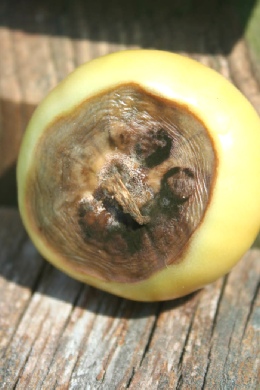




 Latest News
Blogs/Links
Features
Latest News
Blogs/Links
Features



Blossom end rot on tomatoes may indicate calcium deficiency
If your tomatoes start developing brown bottoms while on the vine, they most likely have the disorder called blossom end rot.
This browning and rotting occurs at the end of the tomato away from the stem where the dried blossom remains or has dropped off. Unfortunately, the browning tends to expand and may even create a flattening of the tomato bottom.
When the tomato plant has either suffered through a significant dry spell or lengthy period of rain as the fruit begins to develop, blossom end rot can occur, writes Mary Ann Hansen, Virginia Tech Extension Plant Pathologist, in the article “Blossom End Rot” (Adapted from a previous publication by Robert Pristou and R.C. Lambe). A lack of calcium, too, can trigger blossom end rot.
Though gardeners can’t save tomatoes that have begun to rot, they can provide the plants with calcium to prevent any future tomatoes from developing the disorder. Also, providing adequate amounts of water during dry spells can help.
To aid with the calcium needs, gardeners can add a teaspoons or two of Epsom salts to the soil beneath the plant, making sure not to get the salts on the plant roots or stem. Then, water afterwards, so the nutrients will reach the plant roots. Adding supplements specifically created to offset blossom end rot as well as amending the soil with gypsum can help, too.
To further protect plants, gardeners can remove rotting fruit to prevent plant stress.



| Seed Companies |
| NC Markets |
| VA Markets & Roadside Stands |
| Community Supported Agriculture |
| NC Markets & Roadside Stands |
| VA Markets & Roadside Stands 2 |
| Calendar |
| Planting Zones |
| Garden Tips |
| Disclosure |
| Fruit and Veggie Info |
| Events/People |
| Gardening How To |